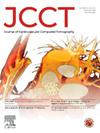非常严重主动脉瓣狭窄:计算机断层扫描主动脉瓣钙评分的诊断价值。
IF 5.5
2区 医学
Q1 CARDIAC & CARDIOVASCULAR SYSTEMS
引用次数: 0
摘要
背景:(A)非常严重的主动脉瓣狭窄(VSAS);Vmax≥5 m/s, MPG≥60 mmHg)是临床预后不良的危重情况。指南将VSAS作为无症状患者考虑瓣膜置换术的一个标准。(B)指南推荐使用主动脉瓣钙(AVC)评分作为区分中度和重度主动脉瓣狭窄(SAS)的参数。本研究的目的是提出AVC阈值来区分SAS和VSAS。方法:回顾性分析单个中心523例经导管主动脉瓣植入术患者的资料。将430例和谐型AS患者分为SAS组(n = 344)和VSAS组(n = 86),比较绝对AVC和指数AVC(体表面积;主动脉瓣环面积)。结果:男性平均AVC (m)显著高于女性(w), VSAS显著高于SAS (m: SAS 3572.0 AU;Vsas 5465.0 au;w: SAS 2252.5 AU;Vsas 3064.5 au;结论:建议的AVC阈值-大约3700 AU (m)和2400 AU (w) -在研究队列中显示出区分SAS和VSAS的显著预测能力。本文章由计算机程序翻译,如有差异,请以英文原文为准。

Very severe aortic valve stenosis: Diagnostic value of computed tomography aortic valve calcium scoring
Background
(A) Very severe aortic valve stenosis (VSAS; Vmax ≥ 5 m/s, MPG ≥60 mmHg) is a critical condition with unfavorable clinical outcomes. Guidelines regard VSAS as one criterion for considering valve replacement in asymptomatic patients. (B) Guidelines recommend the use of aortic valve calcium (AVC) scoring as a parameter to differentiate between moderate and severe aortic valve stenosis (SAS). The aim of our study is to propose AVC thresholds for the discrimination between SAS and VSAS.
Methods
Data of patients from a single center who underwent transcatheter aortic valve implantation (n = 523) were retrospectively analyzed. Patients with concordant AS (n = 430) were divided into SAS (n = 344) and VSAS (n = 86) groups and compared in terms of absolute AVC and indexed AVC (body surface area; aortic valve annulus area).
Results
Mean AVC was significantly higher in men (m) than in women (w), and significantly higher in VSAS than in SAS (m: SAS 3572.0 AU; VSAS 5465.0 AU; w: SAS 2252.5 AU; VSAS 3064.5 AU; all p < 0,001). ROC curve analyses showed AVC to be a predictor of VSAS in both sexes (m: AUC 0.794; p < 0.001; w: AUC 0.725; p < 0.001), with optimal cut-off values of 3706.5 AU (m) and 2374.5 (w). Some indexed AVC had a slightly, but not relevantly, better predictive value.
Conclusion
The proposed AVC thresholds – approximately 3700 AU (m) and 2400 AU (w) - showed significant predictive power to differentiate SAS from VSAS in the study cohort.
求助全文
通过发布文献求助,成功后即可免费获取论文全文。
去求助
来源期刊

Journal of Cardiovascular Computed Tomography
CARDIAC & CARDIOVASCULAR SYSTEMS-RADIOLOGY, NUCLEAR MEDICINE & MEDICAL IMAGING
CiteScore
7.50
自引率
14.80%
发文量
212
审稿时长
40 days
期刊介绍:
The Journal of Cardiovascular Computed Tomography is a unique peer-review journal that integrates the entire international cardiovascular CT community including cardiologist and radiologists, from basic to clinical academic researchers, to private practitioners, engineers, allied professionals, industry, and trainees, all of whom are vital and interdependent members of our cardiovascular imaging community across the world. The goal of the journal is to advance the field of cardiovascular CT as the leading cardiovascular CT journal, attracting seminal work in the field with rapid and timely dissemination in electronic and print media.
 求助内容:
求助内容: 应助结果提醒方式:
应助结果提醒方式:


